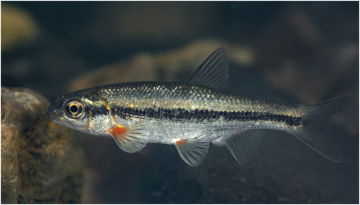Paper: Survival and swimming performance of PIT-tagged Telestes muticellus
 Italian riffle dace (Photo: Mattia Nocciola)
RIBES Early Stage Researcher Alfredo Schiavon together with fellow ESR Usama Ashraf and RIBES Supervisors Franz Hölker, Claudio Comoglio, and Daniel Nyqvist and others Alessandro Candiotto, recently published the paper “Survival and swimming performance of a small-sized Cypriniformes (Telestes muticellus) tagged with passive integrated transponders” in Journal of Limnology.
Italian riffle dace (Photo: Mattia Nocciola)
RIBES Early Stage Researcher Alfredo Schiavon together with fellow ESR Usama Ashraf and RIBES Supervisors Franz Hölker, Claudio Comoglio, and Daniel Nyqvist and others Alessandro Candiotto, recently published the paper “Survival and swimming performance of a small-sized Cypriniformes (Telestes muticellus) tagged with passive integrated transponders” in Journal of Limnology.
In the abstract they write: Italian riffle dace (Telestes muticellus, Bonaparte 1837) is a small-bodied Leuciscidae native to the Italian Peninsula, of which little is known about the ecology and individual movements in nature. Passive Integrated Transponder (PIT) telemetry is used to track fish movements and behaviour. The basic assumption is that the PIT-tagged organism's performances do not differ considerably from their natural behaviour. Here we present the first evaluation of potential tagging effects in the genus Telestes. The survival rate and tag retention were compared between two different tag implantation methods – injector gun and scalpel incision - and pit-tagging effects on swimming performance were evaluated. Five weeks after tagging, Italian riffle dace demonstrated high survival rates in all treatments: 94.8% for fish tagged with injector gun (n=58), 100% for scalpel incision method (n=58), and 98.3% for controls (n=58). The tag retention was 96.6% for gun treatment and 100% for scalpel treatment. Prolonged swimming performance, tested 22-23 days after tagging, showed a reduction in endurance (time-to-fatigue) for scalpel treatment (n=22) compared to the control group (n=21), while no difference in maximum swimming velocity was observed. We conclude that PIT tagging is a suitable technique for Italian riffle dace, showing high survival and PIT retention and no effect on maximum swimming speed. Significantly lower prolonged swimming performance, although likely less ecologically important, shows that tagging is not without costs. Potential biases need to be evaluated on a study-by-study basis, and future studies should explore behavioural tagging effects in nature.
